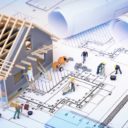
The Commerce Department said Wednesday single-family housing starts rose by 7.2 percent to a seasonally adjusted annual pace of 728,000 units. The December numbers were at the highest level in more than 6-1/2 years, or March of 2008, and are one of the first good pieces of data out of the sluggish housing market in months.
That rise in the largest part of the market offset a 0.8 percent decline in groundbreaking for the volatile multi-family homes segment, which increased overall housing starts 4.4 percent to a 1.09 million-unit rate last month.
Economists polled by Reuters had forecast starts increasing to a 1.04 million-unit pace.
Despite other economic indicators suggesting growth and a recovery, the housing market has lagged behind, as zero wage gains are sidelining first-time buyers from the market and forcing many young adults to stay living at home with their parents or share homes with other relatives and friends.
Higher house prices and stringent lending practices by financial institutions also have been a constraint, despite the increased risk injected into the market via government intervention by the Federal Housing Administration.
As a result, residential construction has been very weak, as well. Experts say the slow pace of homebuilding has been a product of high debt loads among recent college graduates and the lack of good-paying jobs.
Household formation is currently running at about 500,000 a year, far below the more than 1-million mark that would signal a robust housing market.
Throughout 2014, groundbreaking increased by 8.8 percent to 1.01 million units, the highest since 2007, but still extraordinarily weak.
Single-family housing starts in 2014 were also the highest in seven years. In December, groundbreaking on single-family projects in the West hit a seven-year high, while starts in the Midwest were the highest since December 2011.
Groundbreaking for multi-family homes, the most volatile segment of the housing market, fell 0.8 percent to a 361,000-unit pace. Overall permits for future home construction fell 1.9 percent to a 1.03 million-unit pace fueled by an 11.8 percent plummeting of the multi-family segment.
Single-family permits rose 4.5 percent to their highest level since January 2008, with permits in the populous South hitting their highest level since February 2008.






